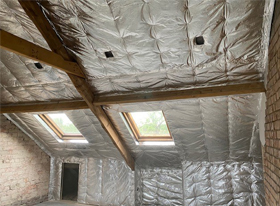Transitioning to Multifoil Loft Insulation from Spray Foam
Advantages of Transitioning to Multifoil Loft Insulation from Spray Foam
If you are currently using or thinking about installing spray foam insulation in your loft, it might be a good idea to reevaluate your choice. Let’s explore the advantages of transitioning to multifoil loft insulation from spray foam.
In previous years, spray foam insulation for loft spaces was promoted as a perfect remedy, however, recent findings have brought to light various problems linked to this option. Homeowners are facing unexpected challenges, including worries about health and a decrease in the value of their property.
There is a bright side to this scenario – there exists a better solution. Multifoil Insulation is a superior and more reliable alternative to spray foam insulation. Our experience in home insulation has helped many households switch from spray foam. Let us show you why making this change could be the best choice for your home.

Health and Safety Concerns with Spray Foam Insulation
Homeowners should be well-informed about the potential health risks associated with using spray foam as a form of loft insulation.
Exposure to Chemicals
The main concern regarding spray foam insulation is its chemical composition. During installation, the release of isocyanates and volatile organic compounds (VOCs) can result in immediate health responses. Moreover, these chemicals may continue to affect the indoor air quality even after the insulation is installed. Manufacturers advise individuals to leave their homes for 24 to 72 hours after the installation of spray foam.
Problems with Ventilation
The application of spray foam in households may lead to ventilation challenges. If not installed properly, it can restrict the circulation of air in attics, leading to concerns like moisture. As spray foam creates an air-tight barrier, it can trap harmful substances in your home including:
- Moisture leading to mould growth
- Chemical off-gassing
- Carbon Dioxide buildup
- Airbourne pollutants
Benefits of Switching to Multifoil Insulation
Multifoil insulation has been proven to be a more favorable alternative to spray foam insulation. Its various advantages make it a perfect solution for your home.
Multifoil Insulation Installation
SuperQuilt is composed of 83% recycled materials, while BreatherQuilt contains 72% recycled materials. The application of these insulation options does not necessitate any protective gear, making them suitable for both expert contractors and DIY enthusiasts seeking a safe and uncomplicated installation procedure. You also don’t need any specialist equipment which if installed yourself could save massively on labour costs.
Properties of Multifoil Insulation
One of the key features of multifoil insulation is its built-in vapour control layer, setting it apart from other forms of insulation. This layer serves to regulate moisture as well as reduce the risk of condensation. As long as it is installed correctly, multifoil insulation offers the following benefits:
- Prevents moisture buildup
- Reduce the risk of mould formation
- Maintains proper airflow
- Creates an effective vapour control barrier when sealed
Ensuring Consistent Temperature Control All Year Round
The use of Multifoil Insulation has created remarkable outcomes in regulating temperature. It efficiently reflects infrared radiant energy into the building during the winter season, while deflecting excessive heat in the summer. This guarantees a consistent indoor temperature all year round, leading to substantial energy preservation.
The Influence of Spray Foam on Mortgages
The guidelines for providing mortgages have become stricter. Presently, the stance of leading lenders in the United Kingdom is as listed:
Some banks, including TSB Bank, Skipton Building Society, Co-operative Bank, and Principality, do not offer mortgages for properties that have been insulated with spray foam. However, Lloyds, Nationwide, Barclays, NatWest Group, and Santander assess mortgage applications on an individual basis. Some lenders may ask for the removal of spray foam within 90 days after the loan has been approved.
Possible Appreciation in Property Value
There are promising signs when it comes to the use of multifoil insulation. The installation of multifoil can lead to better Energy Performance Certificate (EPC) scores, resulting in an appreciation of property value. This holds even more significance due to the potential consequences of spray foam issues on around 300,000 properties. Properties that have been insulated with multifoil remain eligible for mortgages and also boast higher energy efficiency rates making them more desirable to potential purchasers.
Summary
Choosing multifoil insulation is the better option. This environmentally friendly substitution provides excellent thermal performance, meeting building regulations and exceeding them. The additional safety benefits make it an attractive choice – it can also be installed without any protective equipment and does not pose any health risks for occupants.

